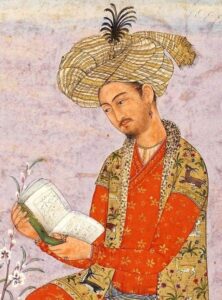Zahiruddin Babar
 Zahiruddin Muhammad Babur (1483-1530) was the founder of the Mughal Empire in India. A descendant of Timur on his father’s side and Genghis Khan on his mother’s side, Babur’s reign marked the beginning of a new era in Indian history with the establishment of Mughal rule.
Zahiruddin Muhammad Babur (1483-1530) was the founder of the Mughal Empire in India. A descendant of Timur on his father’s side and Genghis Khan on his mother’s side, Babur’s reign marked the beginning of a new era in Indian history with the establishment of Mughal rule.
Achievements:
- Foundation of the Mughal Empire: Babur’s most significant achievement was the establishment of the Mughal Empire in India. He laid the foundations after his decisive victory at the Battle of Panipat in 1526 against Ibrahim Lodi.
- Military Conquests: Babur secured several key victories, including the Battle of Khanwa in 1527 against Rana Sanga of Mewar and the Battle of Ghaghra in 1529 against the combined forces of Afghans and the Sultan of Bengal.
- Introduction of Modern Warfare: Babur introduced advanced military tactics and artillery in Indian warfare, which were critical in his conquests. His use of field artillery at the Battle of Panipat is particularly noted for its effectiveness.
- Cultural Patronage: A patron of arts and literature, Babur left behind a rich cultural legacy. He authored the Baburnama, an autobiography written in Chagatai Turkish, providing insights into his life, his thoughts, and the sociopolitical landscape of his time.
Reforms:
- Administrative Reforms: Babur began the process of establishing a centralized administrative system, which would be further developed by his successors. He appointed governors (Subahdars) to manage different regions.
- Economic Reforms: He took steps to improve the economic stability of his newly founded empire. Babur’s efforts in agriculture included the promotion of farming and irrigation, which helped stabilize food production.
- Religious Policies: Babur practiced relative religious tolerance compared to many contemporary rulers. While a devout Muslim, he allowed a degree of freedom in religious practices, which helped in consolidating his rule over a diverse population.
- Urban Development: Babur paid attention to the development of cities and towns, focusing on building gardens and ensuring a pleasant urban environment. His interest in horticulture is reflected in the various gardens he laid out, such as the famous Ram Bagh in Agra.
Trivia and Lesser-Known Facts:
- Babur was a polyglot and was fluent in Turkish, Persian, and Arabic. His memoirs, the Baburnama, are considered a masterpiece of Turkish literature.
- Unlike many conquerors, Babur had a deep appreciation for nature and often wrote about his love for gardens, fruits, and flowers.
- Babur’s original intention was to reclaim his ancestral homeland in Central Asia, but he turned his attention to India due to continuous opposition in the west.
- He is known for his distinctive style of fortifications, combining Timurid and Indian architectural elements.